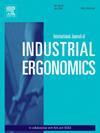一种基于三维点云和二维图像的个性化女性原型图案生成方法
IF 3
2区 工程技术
Q2 ENGINEERING, INDUSTRIAL
International Journal of Industrial Ergonomics
Pub Date : 2025-05-01
DOI:10.1016/j.ergon.2025.103748
引用次数: 0
摘要
如何方便快捷地获取充足的体型数据,生成个性化的剪裁图案,是推动服装在线定制和虚拟试衣的一大挑战。本研究提出了一种基于三维点云和二维图像的个性化女性原型图案生成方法,并开发了基于身高、体重和图像的图案自动生成系统。采用特征点识别方法对人体特征点处的宽度、厚度、角度等14个人体参数进行测量。然后对这些参数与20个模式测点坐标进行多元线性回归。对于提取的二维身体参数,与三维测量数据相比,80%以上的样本误差在1 cm以内。此外,生成的单个模式的预测准确率总体达到91%,证明了该系统的可靠性。因此,该方法可以提高服装自动化生产的效率,满足日益增长的可持续发展和个性化消费的要求。本文章由计算机程序翻译,如有差异,请以英文原文为准。
An integrated 3D point cloud and 2D image-based approach for generating individualized female prototype pattern
To promote online garment customization and virtual fitting, how to obtain sufficient body shape data easily and quickly to generate personalized tailoring patterns is still a challenge. In this study, an integrated 3D point-cloud and 2D image-based approach for generating individualized female prototype patterns was proposed, and an automatic pattern generation system based on body height, weight, and images was developed. A feature point recognition method was used to measure 14 body parameters, including the width, thickness, and angles at characteristic body landmarks. Multiple linear regressions between these parameters and the coordinates of 20 pattern measurement points were then performed. For the extracted 2D body parameters, the error for more than 80 % of the samples were within 1 cm by comparing with the 3D measurement data. Moreover, the predicted accuracy of the generated individual patterns reaches 91 % overall, demonstrating the reliability of this system. Therefore, this method can improve the efficacy of automatic garment production, and meet the growing requirements of sustainable development and individualized consumption.
求助全文
通过发布文献求助,成功后即可免费获取论文全文。
去求助
来源期刊
CiteScore
6.40
自引率
12.90%
发文量
110
审稿时长
56 days
期刊介绍:
The journal publishes original contributions that add to our understanding of the role of humans in today systems and the interactions thereof with various system components. The journal typically covers the following areas: industrial and occupational ergonomics, design of systems, tools and equipment, human performance measurement and modeling, human productivity, humans in technologically complex systems, and safety. The focus of the articles includes basic theoretical advances, applications, case studies, new methodologies and procedures; and empirical studies.

 求助内容:
求助内容: 应助结果提醒方式:
应助结果提醒方式:


